Flowers for Birds: Grow the Plants That Birds Like
Updated: Jun. 20, 2023
Attract more birds to your yard with these seasonal plant picks. Grow flowers and plants that birds like to attract a flock.
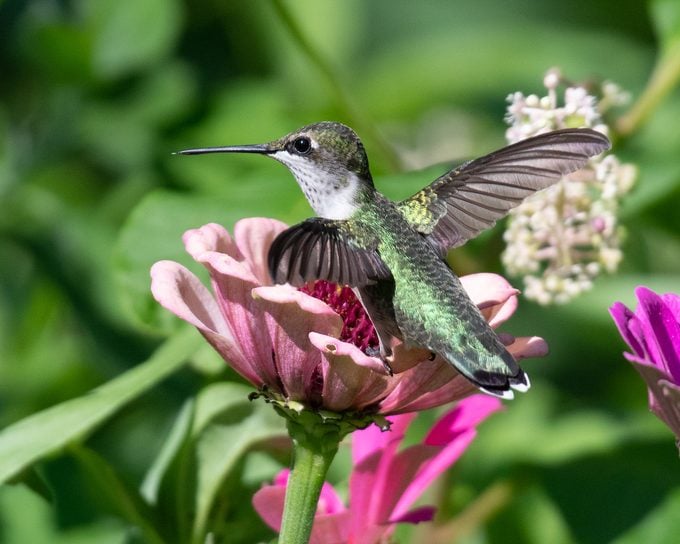
To attract birds with flowers, you’ve got to have the right plants that birds like. A lot of flowers, shrubs and trees adorn your backyard with interesting textures, bright colors and delicious scents. Use this guide to make sure you give the birds and other creatures what they need most in your yard in every season.
For a big splash of color that lasts for months, you can’t beat annual flowers. But beauty is only the beginning. Once the blooms of graceful cosmos, cheerful sunflowers, dramatic dark-leaved amaranths, bold zinnias and other easy-to-grow annuals start to fade, the real fun begins. That’s when they bring in the birds!
Even the best feeder foods often take a backseat to flower seeds. And watching a flock of goldfinches forage naturally among your plants is even more entertaining than seeing them on a tube feeder. That’s true for the dozens of bird species that avidly eat the seeds of flowers, whether it’s northern cardinals snapping up gomphrena, towhees carefully taking tithonia, or native sparrows and juncos energetically scratching beneath the marigolds. And don’t forget to mix in nectar plants for hummingbirds and berries for fruit eating birds.
Grow a goldfinch garden with their favorite plants.
Grow Plants for Birds—and Backyard Entertainment
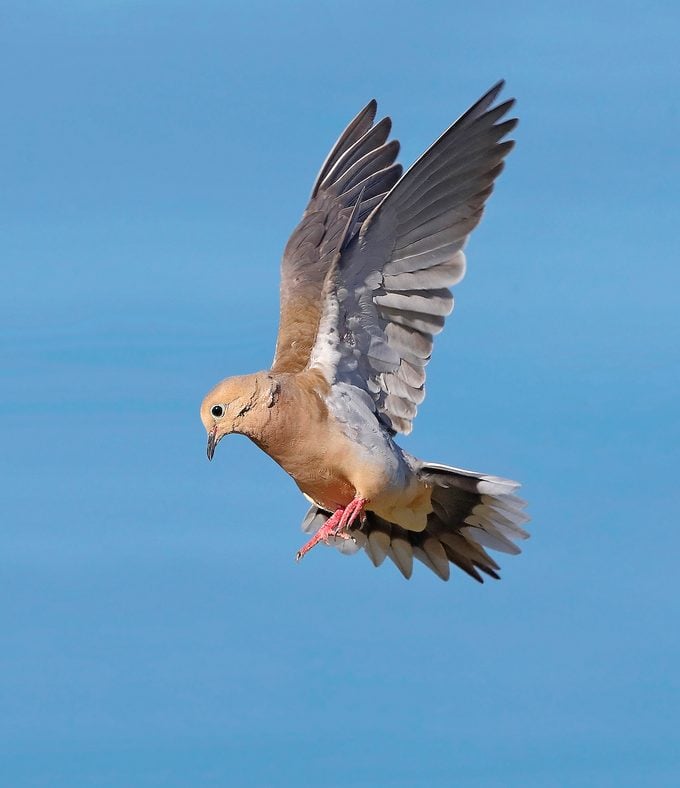
Wildlife biologist Terry W. Johnson of Georgia marvels at the appeal. “When you see how small some of these seeds are, and how hard the cardinals work to get the tiny seeds when right nearby are black oil sunflower seeds at the feeder, it’s amazing!” he says. Annuals typically begin to attract songbirds in late summer, when the first flowers start to produce seeds.
“If zinnias are blooming on your deck or in your garden, keep your eyes peeled for petals scattered beneath the plants,” Terry urges. It’s a clue that goldfinches have been enjoying a late summer banquet, even before the seeds fully ripen. Terry sees the same telltale sign of bird activity beneath his containers of scarlet sage, a native wildflower that he has discovered is a favorite of northern cardinals.
Psst—make sure you grow plants for nesting birds
Watch Plants Closely for Seed Eaters
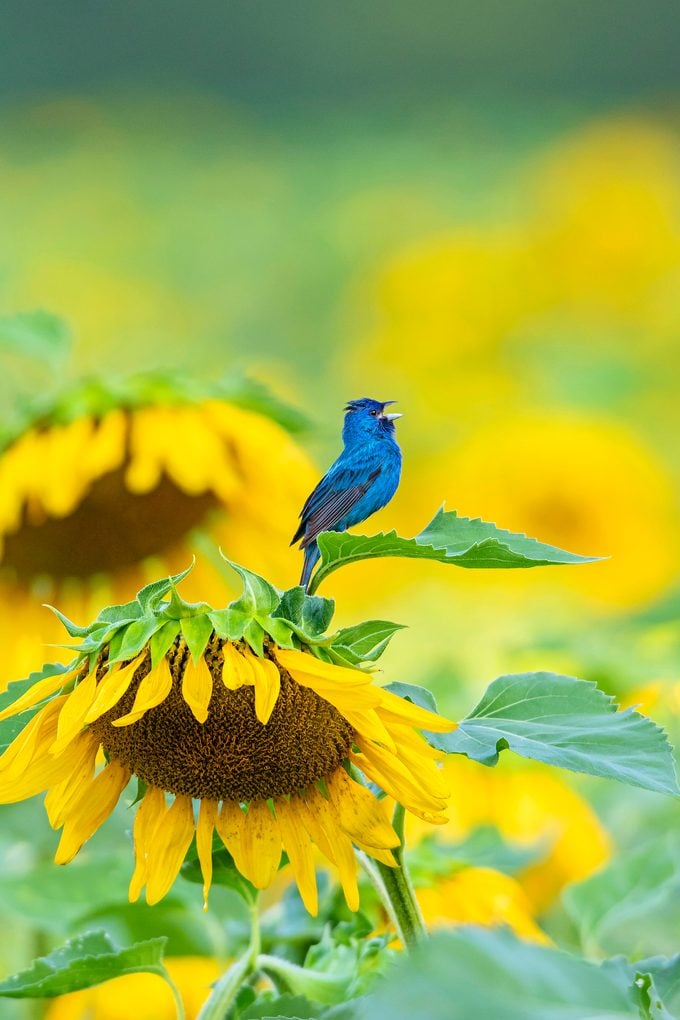
Seed eaters are surprisingly tricky to spot among flowers and foliage. Watch for motion—of both birds and plants. Willowy cosmos stems sway under the weight of goldfinches; marigolds and ornamental millet will bend to the ground as juncos and sparrows jump up to pull down seed heads; flashes of wings will give away cardinals, jays, chickadees and others sampling the sunflowers.
“While I was drinking my coffee and gazing out the window over the kitchen sink, I saw the globe amaranth plants in one of our deck containers violently shaking,” Terry says. “A female cardinal had landed on them and was pulling apart their flower heads! After tearing apart several blossoms to reach the tiny seeds hidden inside, the bird snipped off an entire flower head and flew away.”
Because annuals put out new blossoms, and lots of them, the bird banquet lasts for months, long after the plants are hit by a killing frost. For gardeners who may be tempted to pull out the dead plants, “simply resist the impulse to create a tidy garden,” Terry says. “Let the plants remain standing if you want to add a new facet to bird feeding. You will be providing a great source of food, and you’ll enjoy watching fascinating behavior.”
Plant these native trees that attract birds.
Attract Birds With Annuals for Every Size Garden
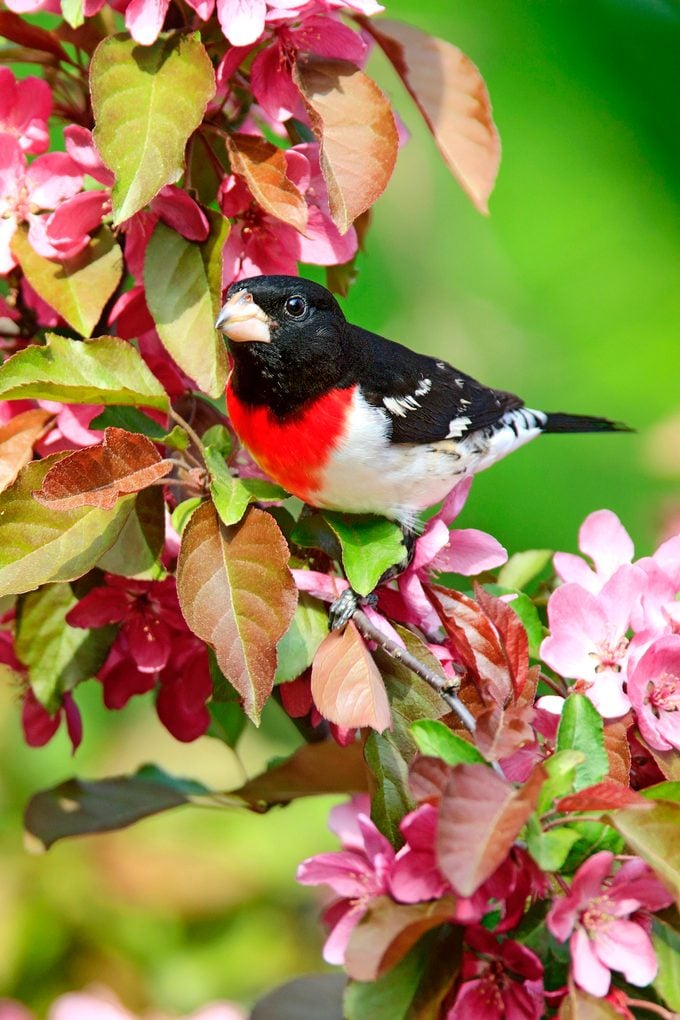
Even a small bed of flowers will bring in the birds. So will container gardens, which Terry and his wife especially enjoy. “As we get older, our eyesight is not as good as it used to be,” he says. “Containers bring wildlife closer to the window. We don’t even have to go outside.” A bigger annual garden will attract more birds, and more kinds of birds. Not only does it offer more seeds, but it also provides the sheltering cover that makes birds feel at home.
Plant annuals around your birdbath, feeder area, garden gnome or other outdoor ornaments, and add containers of them to your garden beds. Human-made objects create a sense of orderliness, even in winter. The flower show may be finished, but songbirds add a whole second act! Try a variety of bird-favored annuals, but grow some of them in dense patches or rows of the same kind, instead of dotting them around.
A concentrated swath of color looks great in bloom—and when seeds ripen, the patch provides the cover that songbirds seek. Be sure to plant some of your annuals a few feet from a favorite window or near an outdoor sitting area, so you can watch birds seek out the seeds as long as they last.
Grow potted flowers and plants that attract hummingbirds.
Annual Flowers That Birds Like
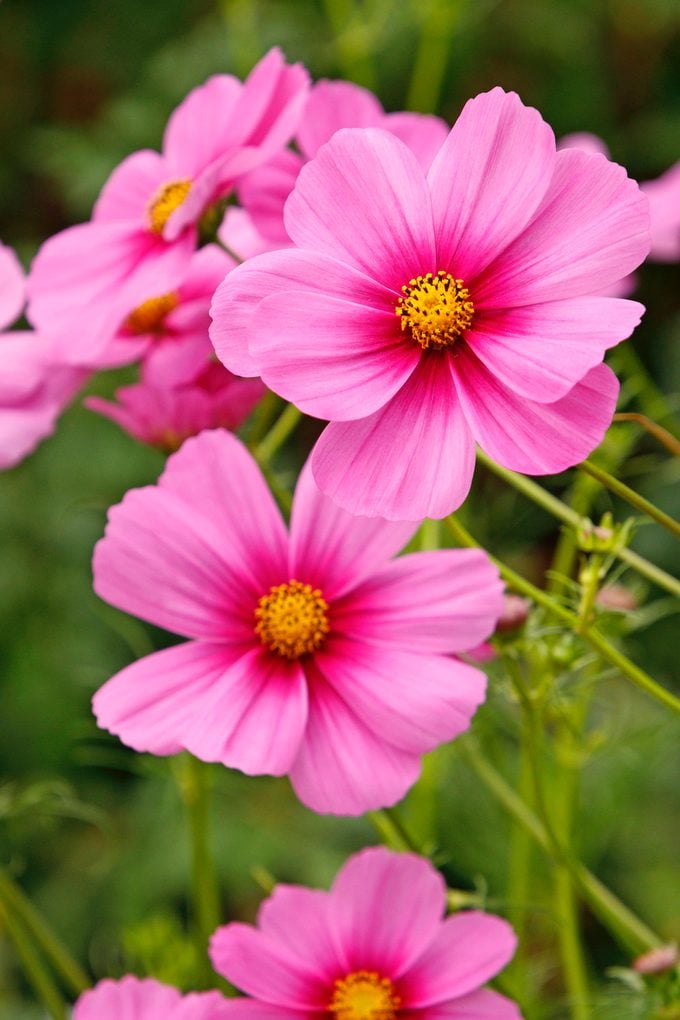
- Amaranth, any kind
- Brightest Brilliant Rainbow quinoa
- Calendula
- Celosia
- Cosmos
- Gomphrena (globe amaranth)
- Marigold
- Ornamental millet, such as Red Jewel or Purple Majesty
- Scarlet salvia (Salvia coccinea)
- Sunflower
- Tall verbena
- Tithonia
- Zinnia
Birds That Eat Flower Seeds
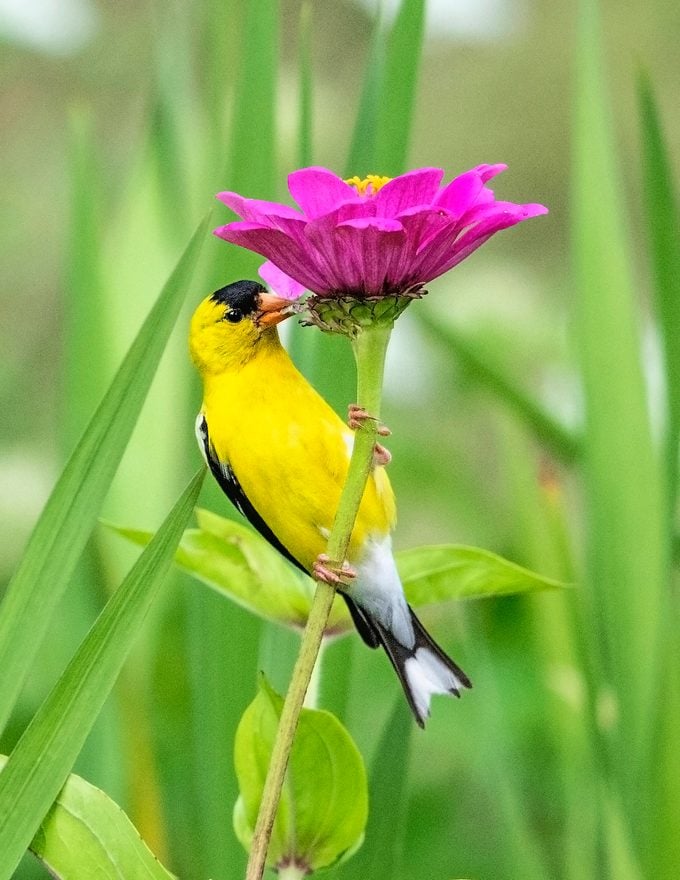
Scatter annual seeds in a sunny spot and lightly cover them for blooms in as little as six weeks, or buy started plants. The most likely diners are goldfinches, native sparrows, juncos, towhees, northern cardinals and mourning doves. Surprises such as grosbeaks, crossbills, buntings, redpolls or pine siskins may show up, too.
Plants to Attract Winter Birds
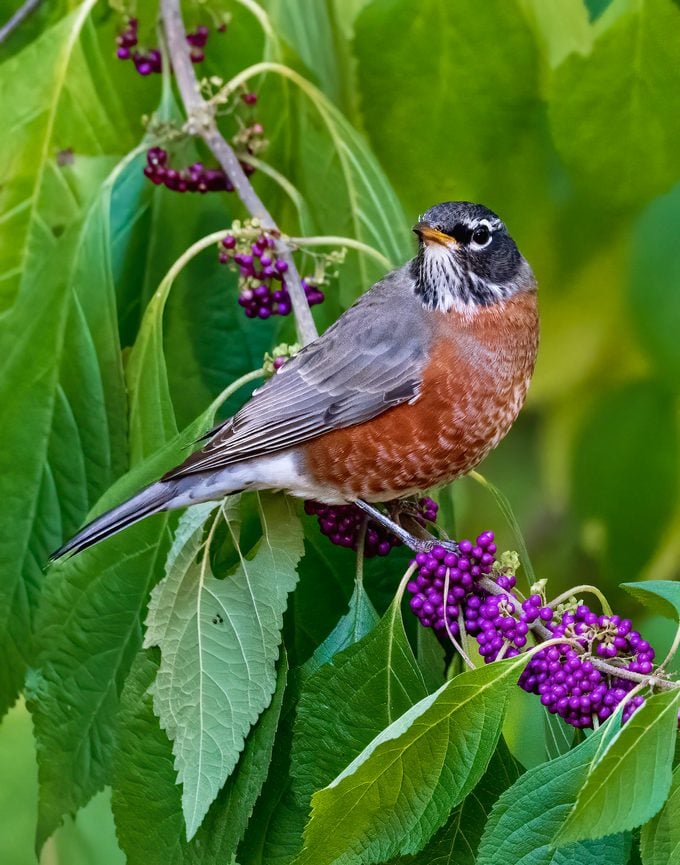
- American bittersweet (Celastrus scandens, Zones 3 to 8) Bittersweet’s showy orange berries are a favorite of more than a dozen bird species. Growing up to 30 feet tall, this vigorous grower gives ample shelter and offers its seeds to hungry birds in the cold months. You’ll need at least one male plant for every five female plants to get fruit.
- American cranberrybush viburnum (Viburnum trilobum, Zones 2 to 7) A boon to gardeners and wildlife alike, this shrub grows 8 to 10 feet tall and wide. Abundant tart red berries appear in summer and stay until late winter, providing both shots of backyard color and food for birds. Plants do best in sun to partial shade and moist, well-draining soil.
- Arborvitae (Thuja occidentalis, Zones 3 to 7) This tree is dense, with a pyramidal shape and clusters of small seed-bearing cones. It has a classic conifer look, offering generous cover for birds. Another plus: You have plenty of cultivars to choose from.
- Beautyberry (Callicarpa species, Zones 5 to 8) Beautyberry is a real showstopper in autumn. Its fall fruit lasts well into winter, or until the birds devour the last bunches of bright-purple berries. Beautyberry is a fast-growing shrub that will reach about 4 feet in height.
- Black chokeberry (Aronia melanocarpa, Zones 3 to 9) A lovely and low-maintenance shrub year-round, this chokeberry develops bluish-black fruit that attracts songbirds in fall and winter. Plants grow to be 3 to 6 feet tall and up to 10 feet wide; they do best in sun or part shade and moist, well-draining soil.
- Blue spruce (Picea pungens, Zones 2 to 8) Birds love the thick branches and prickly needles that provide winter shelter. The cones produce seed for food. This tree will do best in full sun and will grow up to 60 feet tall.
- Boxwood (Buxus species, Zones 4 to 9) Often used for hedges and topiaries, this dense evergreen shrub is covered in masses of green or variegated foliage and thrives in partial shade. Its density makes it a favorite of birds for winter cover. Many slow-growing cultivars reach just 5 feet or less.
- Firethorn (Pyracantha coccinea, Zones 5 to 9) Looking for beauty in your backyard beyond fall? Firethorn has glossy green foliage for most of the year, but it’s the compact bunches of pea-size berries that get all the attention.
- Hawthorn (Crataegus, Zones 3 to 9) Commonly used as a border tree in backyard landscapes, hawthorn is a haven for birds looking for nesting and perching sites. The tree thrives in full sun and grows to be 20 to 45 feet tall.
- Hemlock (Tsuga, Zones 4 to 8) Hemlock trees are shade-tolerant, especially when they’re young, and are popular for hedges. One variety in particular, Cole’s Prostrate, has a weeping look with a low, spreading habit and cascading branches. It provides dense shelter for ground-feeding birds like towhees and juncos.
- Holly (Ilex species, Zones 5 to 9) This winter classic is practically a necessity for bird lovers. Its beautiful green foliage supplies winter protection for flying visitors, and its bright berries are nourishing. Different holly species range from small bushes to 60-foot trees.
- Red chokeberry (Aronia arbutifolia, Zones 4 to 9) Growing 6 to 10 feet high, this resilient shrub does well even in poor soil, tolerating wet and dry conditions. It has small white or reddish blooms in spring, glossy foliage in summer and bright-red berries in fall and early winter.
- Serviceberry (Amelanchier species, Zones 3 to 9) These small trees or shrubs provide four seasons of interest in just about any landscape. The berries draw northern mockingbirds, brown thrashers, northern flickers, downy woodpeckers and more later in the year.
- Sumac (Rhus species, Zones 3 to 10) Sumac is a durable shrub or small tree that’s attractive year-round. In winter, it boasts spikes of red fruit that are an excellent source of nutrition for winter residents.
- Winterberry (Ilex verticillata, Zones 3 to 9) Few deciduous shrubs are as showy in winter as winterberry. It drops its leaves in fall, so nothing detracts from the brilliance of the red berries. Many gardeners find winterberry a must for cold-weather landscaping, and it’s easy to see why. You’ll love the colorful fruit, and the birds will love you for growing it.
Plants to Attract Spring Birds
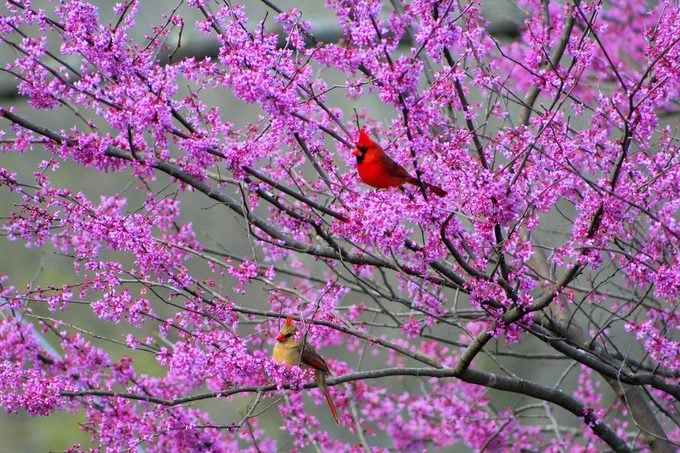
- Bachelor’s buttons (Centaurea cyanus, annual) Also known as cornflowers, bachelor’s buttons bloom in late spring through summer. The wide purple and bluish flowers look like buttons. For spring blooms, be sure to sow seeds in early fall. Likely visitors are finches, buntings and sparrows.
- Baptisia (Baptisia, Zones 3 to 9) These pretty flowers look like pea blossoms and are usually blue. A single plant can grow to be 5 feet high and 2 feet wide. Baptisia sprouts interesting seedpods that will bring in the birds.
- Buckeye (Aesculus species, Zones 3 to 8) If you’re looking to add some charm to your landscape, plant a buckeye shrub or small tree. The leaves of red buckeye are distinctive, and the showy red flowers will attract hummingbirds while providing shelter for other birds in spring.
- Butterfly weed (Asclepias tuberosa, Zones 3 to 9) Not solely for butterflies, this plant is truly multipurpose. Hummingbirds, too, love its nectar, and goldfinches and orioles are among the birds that use the silky seed down as nesting material.
- Camellia (Camellia, Zones 6 to 11) This popular evergreen flowers in the fall, winter or early spring, depending on the variety. Ideal for landscaping, it has lovely rose-shaped blooms, usually in red, pink or white. Birds will appreciate the shrub during nesting season. Expect camellia to be anywhere from 3 to 20 feet high.
- Cherry (Prunus species, Zones 3 to 9) Beautiful pink blooms open in spring, and small red or black fruit appears in summer. The birds will welcome the shelter and eat up the berries in summer. Cherry trees come in dwarf varieties if you don’t want a large one.
- Columbine (Aquilegia, Zones 3 to 9) The blooms of columbine are truly stunning. Hummingbirds and butterflies love them, too! Remove spent blossoms to encourage more to form into early summer. Avoid fertilizing too much, which results in fewer blooms.
- Foxglove (Digitalis, Zones 3 to 10) Foxglove is a short-lived perennial or a biennial. Its tubular, bell-shaped blooms come in a variety of colors: apricot, pink, golden brown, coppery rose and more. Hummingbirds love the flowers.
- Fuchsia (Fuchsia species, annual to Zone 8) Fuchsia’s showy red, white, pink and purple blooms will capture your heart and bring in the hummingbirds. There are more than 100 kinds, from low-growing dwarfs to upright varieties. Most plants are 6 to 24 inches. Fuchsia grows best in partial shade.
- Lupine (Lupinus perennis, Zones 3 to 9) Lupine blooms from late spring to early summer. It grows to about 3 to 4 feet tall and produces spires of blooms that look like pea blossoms. Lupine will do best in full sun to partial shade.
- Phlox (Phlox, Zones 3 to 9) These old-fashioned beauties attract hummingbirds and butterflies as soon as they start blooming in spring. The flowers, prized for their scent, come in many colors, sizes and bloom times. Most varieties prefer full sun.
- Pine (Pinus, most zones, check species) Pines provide the shelter and nesting space that spring birds need. Plant trees any time from spring to fall in moist, well-draining soil. But beware: Some pine trees can grow to be 75 feet tall.
- Redbud (Cercis species, Zones 4 to 10) Redbud’s blooms attract hummingbirds and butterflies, as well as pollinating insects that benefit your backyard. The seeds appeal to chickadees, goldfinches and others, and nuthatches and woodpeckers love the insects in the bark.
- Red-hot poker (Kniphofia, Zones 5 to 9) It’s easy to see why this plant is also called a torch lily. Birds love this stately flower, which changes in color from yellow at the base to bright red at the tip. Depending on the cultivar, it will bloom in late spring to autumn, and attract flocks of hummingbirds along the way.
- Rhododendron (Rhododendron species, Zones 4 to 9) Plant rhododendron in a lightly shaded area with protection from winter sun and winds. Moist, acidic soil that drains well will help it thrive. Rhododendron offers ample shelter and enticing nectar.
- Viburnum (Viburnum species, Zones 3 to 10) This bush draws a variety of birds with nesting space and summer-to-winter fruit. Viburnum is among the most popular ornamental shrubs and small trees because it’s beautiful, versatile and easy to grow.
Plants That Summer Birds Like
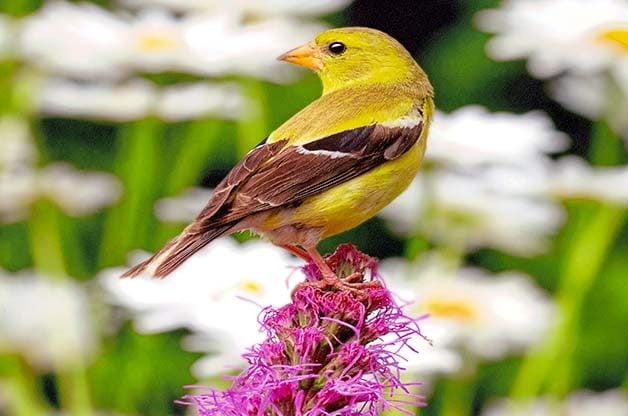
- Bee balm (Monarda, Zones 3 to 9) If you want to lure hummingbirds and butterflies, this easy-to-grow perennial is a good selection. Its bright colors and nectar-filled blooms attract a variety of pretty fliers. This beauty grows up to 4 feet tall and starts flowering in midsummer.
- Black-eyed Susan (Rudbeckia species, Zones 3 to 9) Birds adore this garden classic. The traditional black-eyed Susan has a dark center and bright-yellow petals, but now there are a few new color combos to choose from. Grow in full sun to light shade for blooms in summer through autumn. House finches, chickadees and American goldfinches will feed on the seed heads.
- Blanket flower (Gaillardia x grandiflora, Zones 3 to 9) Blanket flower will bloom all summer, showing off its red and yellow blooms with purple centers. The plant is generally 2 to 3 feet tall and does best in full sun.
- Coral bells (Heuchera, Zones 3 to 9) Rich, fertile soil is best and partial shade ideal for this handsome plant. Coral bells are valued for their colorful, often purple foliage. In late spring, the plant sends up attractive, long-lasting wands of tiny flowers that hummingbirds will love.
- Coreopsis (Coreopsis species, Zones 3 to 11) Nectar-rich blooms appeal to hummingbirds and butterflies, while the seeds provide food for sparrows, chickadees, finches and other seed-eating birds. Plant drought-tolerant coreopsis in full sun.
- Cosmos (Cosmos bipinnatus, annual) Birds can’t resist these colorful pinwheel-shaped blooms nestled in feathery foliage. Grow single or double cultivars in full sun, and you’ll have flowers and seeds from summer through fall.
- Flowering tobacco (Nicotiana alata, annual) For a no-fuss way to liven up your garden with hummingbirds and butterflies, plant flowering tobacco. The stems rise from a rosette of leaves and are covered with star-shaped flowers in shades of pink, red, maroon, lavender, white, yellow and even green.
- Liatris (Liatris spicata, Zones 3 to 9) Also called gayfeather or blazing star, this flower shines in late spring through summer. It attracts hummingbirds to its spikes of lavender, rose or white blossoms. American goldfinches, tufted titmice and other seed eaters savor its seed heads.
- Penstemon (Penstemon species, Zones 3 to 10) Hummingbirds love these red, purple, blue, pink and white flowers on plants that reach up to 4 feet, blooming profusely for most or all of the summer. Full sun and well-draining soil are ideal; damp or rich soil makes penstemon rot.
- Primrose (Primula vulgaris, Zones 4 to 8) English primrose is a favorite of hummingbirds, butterflies and bees because of its alluring fragrance in early summer. It’s generally a profuse bloomer, doing best in partial shade.
- Purple coneflower (Echinacea species, Zones 3 to 10) The large, showy blooms of coneflowers will attract birds, butterflies and bees. Plant bare-root perennials in spring, or plant container-grown specimens any time during the growing season. Cut back half your coneflowers in early summer to delay flowering and prolong overall bloom time.
- Salvia (Salvia species, Zones 4 to 9) Annual salvia is a garden favorite, but don’t forget the perennials. Loose flower spires reach heights from 1 to 5 feet. The blooms come in bright shades of red, maroon, purple and indigo—and hummingbird love them!
- Stokesia (Stokesia laevis, Zones 5 to 9) Blooming from early summer until fall, stokesia boasts 3- to 5-inch-wide blue, lavender or pink blooms with ragged-toothed petals around a creamy center. Regular deadheading will extend blooms and ensure plenty of bird activity.
- Trumpet vine (Campsis radicans, Zones 4 to 9) Trumpet vine blooms are orange-red in color and tubular in shape, making them a favorite of hummingbirds. Surprisingly, this vine can grow to be 40 feet tall. Plant it in full sun.
- Yarrow (Achillea species, Zones 3 to 10) Flattened clusters of tiny flowers attract hummingbirds and butterflies, while the seeds of yarrow appeal to many songbirds.
- Zinnia (Zinnia, annual) An old-fashioned favorite, zinnias are best loved for their long-lasting blooms, which require minimal care. The flowers will attract hummingbirds and butterflies in the heat of summer. And without deadheading, zinnias will bloom into fall.
Plants to Attract Fall Birds
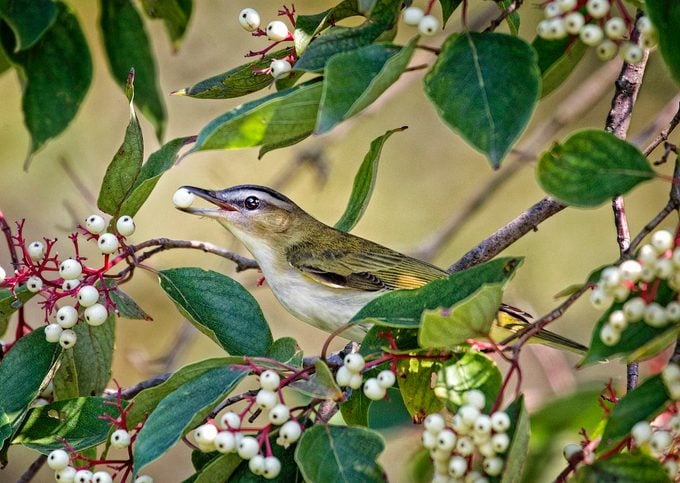
- Aster (Aster species, Zones 3 to 8) The aster brings an explosion of color to the end of the growing season, a guaranteed lure for fall butterflies. From miniature alpine plants to giants up to 6 feet tall, it will brighten up fall in your backyard. Plant early in the season in Northern states so it can get established before winter.
- Crabapple (Malus species, Zones 2 to 9) These highly decorative flowering trees produce small fruits that attract more than 20 bird species but are especially favored by cedar waxwings, robins and northern cardinals. Crabapple varieties tend to be 10 to 25 feet tall and grow best in full sun.
- Dogwood (Cornus species, Zones 2 to 8) Bursting with berries, this garden favorite feeds robins, bluebirds, cardinals and dozens of other backyard birds during the colder months. Dogwoods do best in full sun to partial shade and prefer moist soil.
- Elderberry (Sambucus species, Zones 3 to 9) A luxurious shrub with long, drooping branches, this elderberry produces flat white clusters of flowers that turn into purple berries in late summer. The fruit is relished by gray catbirds, robins, bluebirds and many other backyard songbirds.
- Fountain grass (Pennisetum alopecuroides, Zones 5 to 9) With full tufts of fuzzy flower spikes that turn into natural birdseed, fountain grass seems to be heaven-sent. One or more of its many varieties, which reach 2 to 5 feet, will add charm to your backyard wildlife habitat.
- Four-o’clocks (Mirabilis jalapa, annual) The blooms of four-o’clocks earn their name, opening in mid-afternoon and fading before sunrise. The nectar-rich flowers are a favorite evening stop for hummingbirds and butterflies.
- Goldenrod (Solidago species, Zones 3 to 9) All it takes is a few goldenrod plants to light up your garden in late summer, and provide birds a continual food source. Also, give the plants plenty of room to spread. They won’t disappoint, especially as many other plants fade.
- Grape (Vitis, Zones 2 to 9) This high-sugar fruit provides lots of energy for birds. The woody deciduous vines grow up to 30 feet long, thrive in full sun and produce late-summer and autumn fruit in a variety of sizes and flavors, some of which are unpalatable to humans.
- Joe Pye weed (Eupatorium purpureum, Zones 4 to 9) Grow Joe Pye weed in average to moist soil. It offers a great supply of seed that birds will love. Pinch back early in the season to grow shorter plants and boost flower production.
- Mahonia (Mahonia, Zones 5 to 11) This evergreen shrub has spiny-edged leaves and, in late summer and fall, bears clusters of blue-black berries. Various species grow from 1 to 12 feet in full sun to light shade.
- Marigold (Tagetes, annual) If brilliant and lasting color is what you’re looking for, look no further. Marigolds are tough garden plants that bloom through fall and attract birds. They grow to be 6 inches to 3 feet tall.
- Mountain ash (Sorbus species, Zones 2 to 7) A good choice for small landscapes, this medium-size mountain ash tree boasts spectacular yellow and red fall foliage. The orange fruit attracts flocks of cedar waxwings, robins, gray catbirds, thrashers, eastern bluebirds and at least a dozen other bird species.
- Nasturtium (Tropaeolum majus, annual) Nasturtiums will bloom from early summer straight through until frost. Extremely low-maintenance plants, they have funnel-shaped flowers and large, veined leaves. Hummingbirds and butterflies will stop to visit the blooms, and it’s also worth noting that all parts of the plant are edible for humans!
- Rugosa rose (Rosa rugosa, Zones 2 to 8) Love roses but hate the hassle? This fast-growing variety flourishes anywhere without the fuss. Rugosa roses handle poor soil conditions, from sandy to salty, and produce bright rose hips that attract countless birds.
- Sedum (Sedum species, Zones 3 to 10) Just when your other plants begin their fall decline, Autumn Fire sedum will take the spotlight with its brightening star-shaped blooms. Most sedums are hardy in all but the coldest climates. The late-autumn seed heads attract birds, including finches and chickadees, so don’t cut them back until spring.
- Sunflower (Helianthus annuus, annual) Sunflowers are dependable bird magnets. Cultivars range from 2 to 15 feet tall and are mainly yellow, although some varieties are red or brown. In early autumn, this stately beauty attracts all seed eaters.
